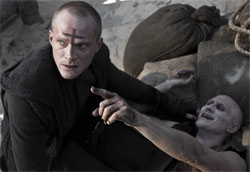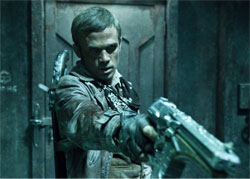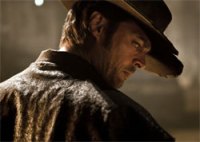Director Scott Charles Stewart seems to be making a career out of erasing Jesus from history, and celebrating supernatural heroes who rebel against God for the greater good … in apocalyptic action/horror movies starring Paul Bettany.
“Let’s pretend the New Testament never happened” is how Stewart reportedly spun his 2010 apocalyptic thriller Legion to Christian actor Doug Jones. Legion is set in an alternate-reality version of the 21st century in which God sends the archangel Gabriel to destroy humanity, but Michael (Bettany) goes rogue to defend mankind against the forces of heaven. (Despite the “New Testament never happened” vibe, stray hints of Jesus’ impact on history crop up here and there, as when a character refers to the “21st century,” or even in the profane use of “Christ.”)
Stewart’s latest is Priest, a thoroughly repugnant Western/wuxia/sci-fi/horror/action mashup, based on a Korean graphic novel, that’s replete with the language and iconography of the New Testament and the church age, particularly the Catholic church. Yet here it’s like the New Testament happened without Jesus—without the Incarnation, without good news, without grace.

There is a “church”; there are “clergy”; there are “priests” who take vows of celibacy and obedience and are called “Father.” There is ritual confession and mention of “absolution,” with words taken directly from the Catholic rite and penance with prescribed recitations of Hail Marys and Our Fathers. There are echoes of the Gospels—but the gospel, the good news, appears to be entirely missing in this world.
There are crosses everywhere, and characters use the sign of the cross in prayer. The film ends with an overtly Eucharistic ritual, celebrated by Christopher Plummer’s evil Monsignor. There’s even a visual echo of Calvary, with three murdered priests hung up on a trio of crosses, like Christ flanked by the two thieves. Yet despite these direct passion-narrative echoes—and the obvious Catholic milieu—there are no crucifixes; the crosses never display a corpus, a depiction of the body of Jesus on the cross. The significance of the cross in this world, like the church itself, is unexplained and unconnected to faith in a historical founder; the cross is only a talisman, a charm or a weapon (often literally; cruciform daggers and throwing stars abound).
The church in this world is depicted as a despotic, Orwellian oligarchy, from much the same mold as Pullman’s Magisterium, brainwashing the masses with mantras like “God protects you; the church protects you” and “To go against the church is to go against God.” This mantra is applied absolutely and across the board, with no fine distinctions between dogma and discipline or acknowledgments regarding the absolute authority of conscience as per the teaching of Thomas Aquinas and Blessed John Henry Newman. (Gosh, that last sentence feels like using a cannon to swat a mosquito, but hey, the mosquito was asking for it.)

The movie’s “priests” are Jedi-like holy warriors who won a great victory in a major war with mankind’s ancient enemies the vampires, which makes Priest sound about 17 million times cooler and more interesting than it is. That’s before adding that it’s also a take-off of The Searchers with Bettany’s Priest in the John Wayne role as a loner veteran unable to reassimilate into society after the war who goes on a quest to save his kidnapped niece (Lily Collins) or kill her if she’s been infected by her vampire captors.
That’s right, vampires (who live on “reservations” after the war) are the new Comanche; and the fact that they’re slavering monsters who are about as articulate and interesting as the cave troll in Fellowship of the Ring removes Priest about as far from The Searchers‘ cross-examination of the Wayne character’s racism as could be imagined. Even Native Americans and others who weren’t offended by the recent “Geronimo” code-name controversy might be put off by this bit of cinematic reimagining.
On the other hand, one of the vampires’ human thralls (“familiars,” they’re called; these vampires apparently can’t make new vampires, but they can still suck you in) maintains that the vampires aren’t evil at all, telling the Priest, “They are what nature made them to be—just like you.” It’s hard to argue with this, since the vampires aren’t corrupted human beings or fallen anything else. (Stewart has said the film takes a “David Attenborough Planet Earth approach to the vampires,” presumably meaning that they’re just another facet of the natural world.)
Likewise, the “priests” aren’t human beings transformed by power from heaven, nor are they part of the church’s fundamental identity; instead, the church’s leadership (the “Monsignors,” confusingly also called the “clergy,” a hierarchical elite entirely distinct from the “priests”) “found” the priests during the vampire war. Vampires and priests are equally oddities of nature in a mythology as bereft of any lapsarian or Fall-related understanding as of grace and redemption. There is no original divine plan, no departure from that plan, no post-lapsarian plan of salvation.

When the Monsignors forbid the Priest to go after his niece, reminding him that “to go against the church is to go against God,” his stoic reply is, “Then I go against God.” He also goes against the half-dozen or so stormtroopers pointing guns at him, and there’s a dramatic slo-mo close-up as the Priest shatters his string of rosary beads behind his back before leaping into action. I thought the rosary beads would turn out to be weaponized (maybe on striking the floor they would release gas or smoke or something). Nope—it’s just a sacrilegious symbolic gesture of the Priest’s willingness to turn his back on his religious obedience.
In a blasphemous distortion of the Catholic act of contrition, the Priest expresses his wish, “with the help of Your grace, to sin no more and to avoid the near occasions of sin—but I can’t.” Later, though, a female priestly warrior called Priestess (Maggie Q of Die Hard 4 and MI:3) argues that going against the church isn’t so significant after all: “Our power doesn’t come from the church—it comes from God. With or without the clergy, we’re still priests.” Choose your poison.
Is it worth pointing out that this depiction of the oppressive, all-powerful “church” is especially odious at a time when Christians are the most persecuted religious group on the planet? Is it worth noting that Bettany, a former Catholic turned atheist, keeps turning up in anti-religious films, from The Da Vinci Code to the Charles Darwin biopic Creation? Is it worth noting that Stewart, who is Jewish, is currently working on an adaptation of The Mortal Instruments, a dark fantasy series with “angels,” demons,” vampires, werewolves, warlocks and so forth? I’ve been thinking lately about Ralph Waldo Emerson’s dictum that “We become what we think about all day long.” What does it do to you to spend a year or more making a film like this, let alone a number of films like this? I spent less than 90 minutes watching Priest and I feel like my brain needs an enema.

Besides The Searchers, Priest is replete with echoes of other better films, from Aliens (an unseen Queen and scary nests full of eggs; a uniformed tough guy named Hicks) to The Matrix (Maggie Q’s Trinity-style catsuit; exhausted slo-mo echoes of bullet time). One of the most depressing echoes of another film, if a fleeting and inadvertent one, comes in the last scene as the Priest confronts Plummer’s Monsignor in the halls of the church. As the Priest walks stoically away, Plummer calls after him, tremulously shouting “Priest!” at his retreating back—in much the same way that Plummer shouted that same title at the retreating back of Gregory Peck nearly thirty years ago in the climactic Colosseum scene (see it here, starting at 8:30) in the terrific TV movie The Scarlet and the Black.
In that film, Peck was the monsignor: a heroic real-life Vatican official named Msgr. Hugh O’Flaherty whose role in saving thousands of Allied soldiers and Jews during World War II earned him the nickname “the Scarlet Pimpernel of the Vatican.” The Scarlet and the Black is one of the most heroic depictions of the church ever filmed. Priest is one of the most repugnantly sacrilegious films I’ve ever seen. While it’s some consolation that reviewing the latter gave me an excuse to mention the former, if I ever, even one time, think of this movie while watching that one, may God give me the grace to forgive the filmmakers.
Talk About It
Discussion starters- Do you wear a cross or a crucifix, or do you have one in your house? Are there any in your church? If not, why not? If so, how important is the cross or the crucifix to you? How does it make you feel to see it? How would you feel to see it misused?
- Did you see Legion? If so, what do Legion and Priest have in common? How are they different? Did you prefer one to the other? Why?
- Where is God in this film? Can you say anything about what he is like? If you saw Legion, how does the God of this film compare or contrast with the God of Legion?
- A villain tells Lucy he wants “not to be told that your every desire is a sin. Face it, if you’re not sinning, you’re not having fun.” How would you answer that claim in real life?
- Do you like vampire stories generally? Why or why not? How does the mythology of this film compare or contrast to the typical vampire mythos? Which do you prefer and why?
The Family Corner
For parents to considerPriest is rated PG-13 for intense sequences of violence and action, disturbing images and brief strong language. There’s lots of deadly fantasy violence and creature menace, including a vampire attack on an entire town and a grisly mock crucifixion scene. There are a couple of sexual references, limited misuse of God’s name and crude language, and one obscenity. Of course there’s lots of twisted and perverse religious content.
Photos © Screen Gems
Copyright © 2011 Christianity Today. Click for reprint information.












